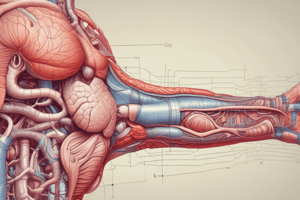Podcast
Questions and Answers
What is the first step in the process of swallowing food?
What is the first step in the process of swallowing food?
- Food is chewed and mixed with saliva. (correct)
- Food is digested in the stomach.
- Food enters the esophagus.
- Food is pushed to the back of the throat.
What is the state of food when it enters the esophagus?
What is the state of food when it enters the esophagus?
- Completely digested
- Partially digested
- In the form of a bolus (correct)
- In liquid form
What mechanism moves the food bolus through the esophagus?
What mechanism moves the food bolus through the esophagus?
- Smooth muscle relaxation
- Gravity
- Peristalsis (correct)
- Contraction of the diaphragm
What are the major functions of the digestive system?
What are the major functions of the digestive system?
Which type of epithelial tissue lines the esophagus?
Which type of epithelial tissue lines the esophagus?
Which structures are part of the gastrointestinal tract?
Which structures are part of the gastrointestinal tract?
What type of muscle is found in the upper third of the esophagus?
What type of muscle is found in the upper third of the esophagus?
What defines an accessory organ in the digestive system?
What defines an accessory organ in the digestive system?
What change occurs at the junction of the esophagus and the stomach regarding the epithelium?
What change occurs at the junction of the esophagus and the stomach regarding the epithelium?
What is the function of the peritoneum in the digestive system?
What is the function of the peritoneum in the digestive system?
How does the structure of the stomach differ from other parts of the digestive tract?
How does the structure of the stomach differ from other parts of the digestive tract?
Which layer of the digestive tract contains epithelial tissue?
Which layer of the digestive tract contains epithelial tissue?
What are rugae, and what is their function in digestion?
What are rugae, and what is their function in digestion?
How do teeth contribute to the digestive process?
How do teeth contribute to the digestive process?
What are the classes of salivary glands and their locations?
What are the classes of salivary glands and their locations?
Why are teeth not considered bones?
Why are teeth not considered bones?
Study Notes
Major Functions of the Digestive System
- Ingestion of food and liquids is the initial step in the digestive process.
- Digestion transforms food into absorbable nutrients.
- Nutrients are absorbed into the bloodstream for utilization by the body.
- Elimination of waste products concludes the digestive process.
Digestive Tract Anatomy
- Mouth: Entry point for food.
- Pharynx: Passage for food from the mouth to the esophagus.
- Esophagus: Tube leading to the stomach.
- Stomach: Site for mechanical and chemical digestion.
- Small intestine: Main location for nutrient absorption.
- Large intestine: Responsible for water absorption and waste management.
- Anus: Exit point for waste elimination.
Accessory Organs
- Accessory organs support digestion but are not part of the digestive tract.
- Includes salivary glands, liver, pancreas, and gallbladder.
Serous Membrane
- The peritoneum is the serous membrane enveloping much of the digestive system.
- Major folded portions: greater omentum, lesser omentum, and mesentery, which provide support and house blood vessels.
Layers of the Digestive Tract
- Serosa: Outermost connective tissue layer.
- Muscularis external: Composed of two muscle layers (inner circular and outer longitudinal).
- Submucosa: Contains loose connective tissue, blood vessels, and nerves.
- Mucosa: Epithelial tissue varying by region, supported by connective tissue (lamina propria) and smooth muscle (muscularis mucosae).
Role of Teeth and Tongue in Digestion
- Teeth are essential for chewing food, increasing surface area for enzymatic actions; composed of enamel and dentin, not bone.
- The tongue mixes food with saliva and aids in swallowing.
Salivary Glands and Saliva Function
- Parotid glands: Near the ear.
- Submandibular glands: Beneath the jaw.
- Sublingual glands: Beneath the tongue.
- Saliva contains enzymes like amylase, initiating carbohydrate digestion and aiding in food lubrication for swallowing.
Swallowing Process (Deglutition)
- Steps: Food is chewed, mixed with saliva to form a bolus, pushed to the throat, and swallowed.
- Bolus: The form of food when it enters the esophagus.
Esophageal Movement and Tissue
- Peristalsis moves the food bolus through the esophagus without the addition of new digestive enzymes.
- Lining: Stratified squamous epithelium; muscle tissue transitions from skeletal muscle in the upper third to smooth muscle in the lower third.
Junction of Esophagus and Stomach
- Epithelium changes from stratified squamous (esophagus) to simple columnar (stomach) at this junction.
Stomach Functions and Structure
- Functions in both mechanical and chemical digestion, particularly of proteins.
- Structured with three smooth muscle layers and includes gastric pits and glands for acid and enzyme secretion.
Rugae
- Rugae are folds in the stomach lining that allow expansion and increase surface area for enhanced digestion.
Gastric Pits and Glands Location
- Located within the stomach lining, crucial for secretion of gastric juices necessary for digestion.
Studying That Suits You
Use AI to generate personalized quizzes and flashcards to suit your learning preferences.
Description
Test your knowledge on the major functions and components of the digestive system with this quiz. Topics include the digestive tract and accessory organs. Perfect for students studying human biology and anatomy.




